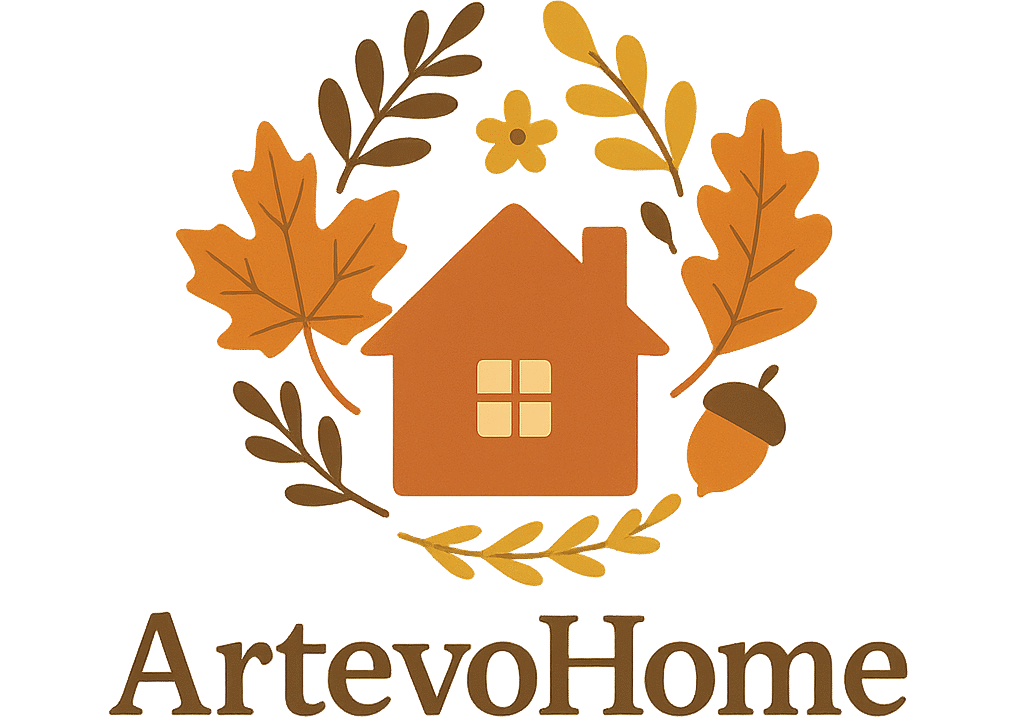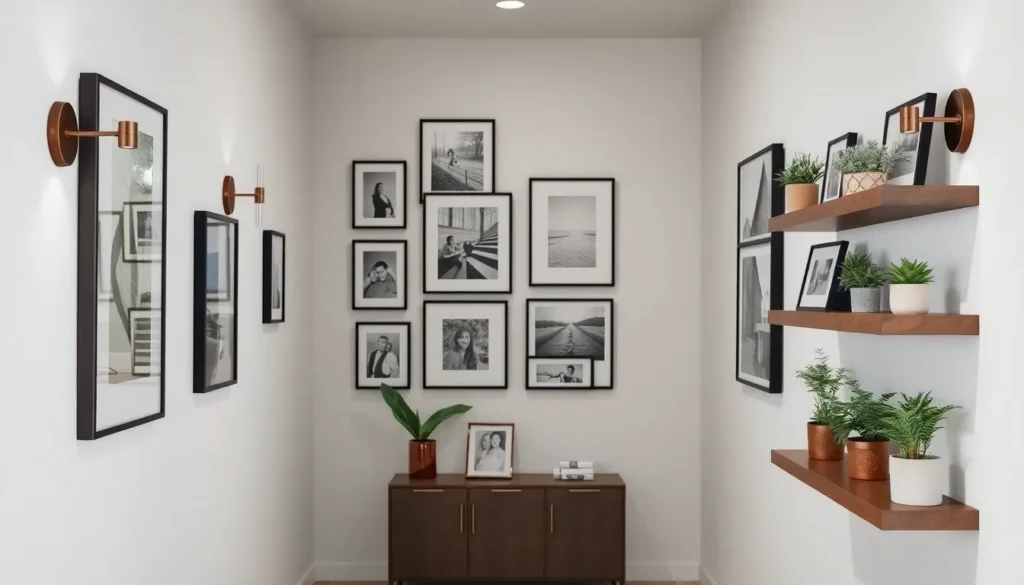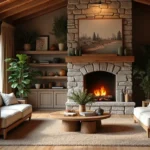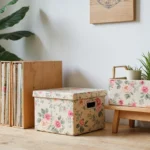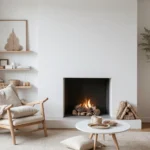Hallways often get overlooked when we’re decorating our homes, yet they’re some of the hardest-working spaces in our houses. These transitional areas connect our favorite rooms and create first impressions for guests. We believe every hallway deserves attention and can become a stunning focal point with the right approach.
Transform your boring corridor into a stylish gallery that reflects your personality and enhances your home’s overall aesthetic. Whether you’re dealing with a narrow entryway, a long hallway, or an awkward space that’s challenging to decorate, we’ve got creative answers that’ll make your hallway shine.
From budget-friendly DIY projects to sophisticated design upgrades, we’ll show you how to maximize every inch of your hallway space. You’ll discover practical storage answers, lighting tricks, and decorative elements that turn forgotten passages into show-stopping features your family and friends will admire.
Create a Gallery Wall to Transform Your Hallway Into an Art Display
Gallery walls serve as powerful focal points that instantly elevate narrow hallway spaces into sophisticated art displays. We’ve discovered that strategic artwork placement can make even the most challenging hallway dimensions feel intentional and inviting.
Choose a Cohesive Color Scheme for Visual Flow
Color coordination creates seamless visual movement throughout your hallway gallery display. We recommend selecting three to four complementary colors that appear in both your artwork and existing decor elements like wall paint, flooring, or nearby room accents.
Neutral palettes work exceptionally well in narrow hallways since they reflect light and create an airy atmosphere. Consider combining warm whites, soft grays, and natural wood tones for a timeless foundation. Bold accent colors like navy blue, forest green, or deep burgundy can add personality without overwhelming the space.
Monochromatic schemes offer another sophisticated approach for hallway art displays. Black and white photography mixed with charcoal sketches creates striking visual impact while maintaining elegant simplicity. We find this approach particularly effective in hallways with limited natural light.
Mix Different Frame Sizes and Shapes for Ever-changing Interest
Frame variety prevents your hallway gallery from appearing static or predictable. We suggest combining standard rectangular frames with square pieces and occasional circular or oval options to create captivating visual rhythm.
Large statement pieces anchor your gallery wall and provide strong focal points in longer hallways. Position these substantial artworks at eye level, typically 57 to 60 inches from the floor to the center of the frame. Medium sized pieces fill transitional spaces while smaller frames add delicate detail work.
Template planning ensures balanced composition before you commit to wall placement. Cut paper templates matching your frame dimensions and tape them to the wall first. This approach lets you experiment with arrangements until you achieve perfect spacing and proportion relationships.
Include Personal Photos and Meaningful Artwork
Personal touches transform generic hallway galleries into meaningful family showcases. We encourage mixing professional artwork with cherished family photographs, travel memories, and handmade pieces that reflect your unique story and experiences.
Family portraits create emotional connections while guests move through your hallway space. Choose images with similar lighting conditions or apply consistent editing styles to maintain visual cohesion. Professional matting and quality frames elevate everyday snapshots to gallery worthy presentations.
Children’s artwork deserves prominent placement alongside purchased pieces in your hallway display. Frame your kids’ drawings and paintings using quality materials to show their importance in your family narrative. Rotating seasonal selections keeps the gallery fresh while celebrating ongoing creative achievements.
Add Statement Lighting Fixtures to Illuminate and Enhance Your Space
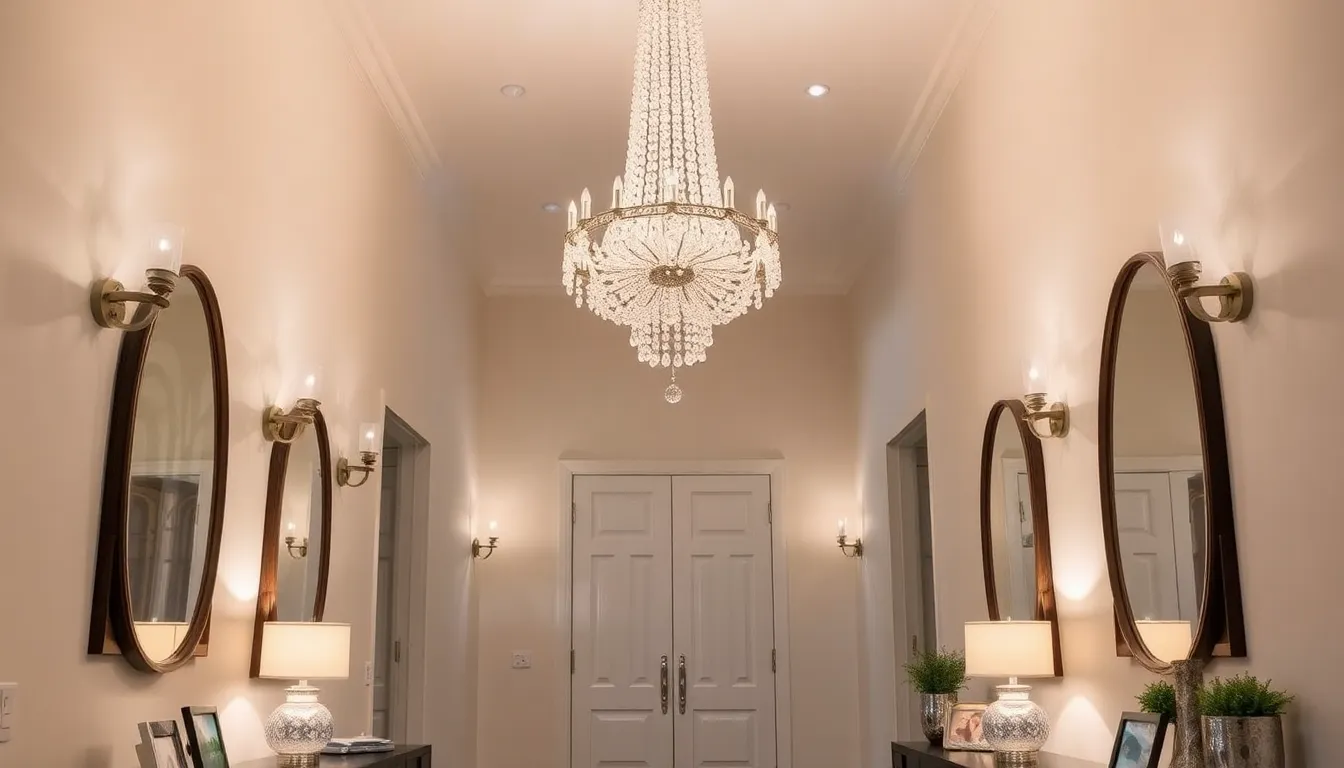
Well-designed lighting transforms hallway spaces from dark transitional areas into welcoming, functional pathways. Statement fixtures serve dual purposes by providing necessary illumination while creating focal points that enhance your home’s overall aesthetic.
Install a Dramatic Chandelier for Grand Impact
Chandeliers create stunning focal points in wider hallways and entryways, transforming these spaces into grand, inviting areas. Oversized or uniquely designed chandeliers work best in hallways with higher ceilings, where they can make a bold statement without overwhelming the space.
Position your chandelier centrally in the hallway to ensure balanced lighting distribution throughout the area. Consider the scale of your space when selecting chandelier size – larger hallways can accommodate more dramatic pieces, while moderate spaces benefit from medium-sized fixtures.
Choose designs that complement your home’s existing style, whether that’s a crystal chandelier for traditional elegance or a modern geometric piece for contemporary appeal. Install the fixture at least 7 feet from the floor to ensure adequate clearance for foot traffic while maintaining visual impact.
Use Wall Sconces to Create Ambient Lighting
Wall sconces provide layered ambient lighting that creates warm, welcoming atmospheres in hallway spaces. These fixtures work particularly well in hallways where ceiling height or width limitations make ceiling fixtures less practical.
Install sconces at eye level, typically 60 to 66 inches from the floor, to ensure optimal light distribution and visual comfort. Space multiple sconces evenly along longer hallways to maintain consistent illumination throughout the entire passage.
Select sconces that direct light both upward and downward to maximize ambient lighting effects and reduce harsh shadows. Use these fixtures to accentuate artwork, architectural features, or decorative elements along your hallway walls.
Coordinate sconce styles with other lighting fixtures in your home to maintain design consistency while adding personality to your hallway space.
Incorporate Table Lamps on Console Tables
Table lamps on console tables provide both decorative appeal and practical task lighting in hallway spaces. This approach works especially well in transitional areas where extra surface lighting enhances functionality and visual interest.
Place console tables strategically along wider hallways to create natural stopping points and display opportunities. Choose lamps that complement your hallway’s color scheme while adding texture and personality through their bases and shades.
Position lamps at varying heights when using multiple console tables to create visual rhythm and prevent monotonous arrangements. Select lamp shades that diffuse light effectively, creating warm pools of illumination that make hallways feel more intimate and welcoming.
Use table lamps to highlight decorative objects, family photos, or small plants displayed on console surfaces, creating curated vignettes that reflect your personal style.
Install Floating Shelves for Both Function and Style
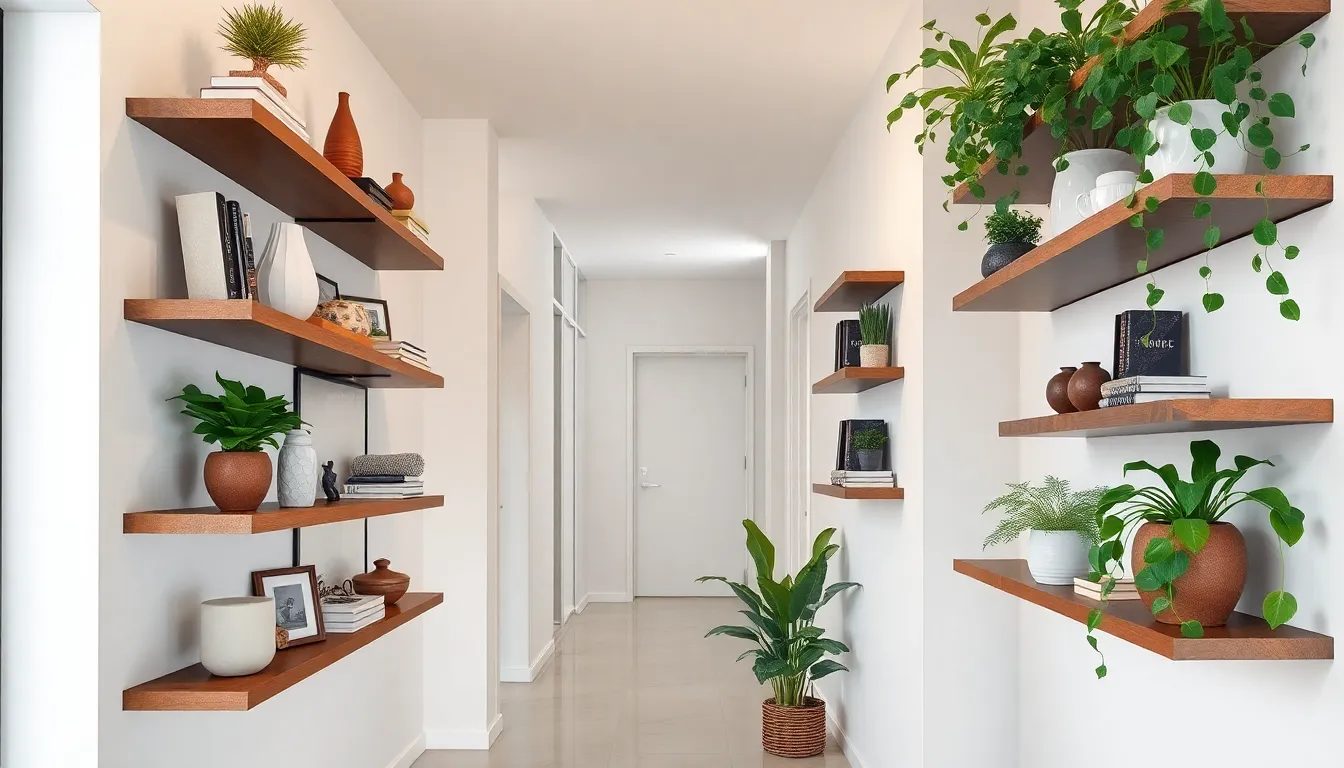
Floating shelves offer the perfect balance between storage and aesthetics in hallway spaces. We love how they maximize vertical space while maintaining a clean, minimalist appearance that complements any decor style.
Display Decorative Objects and Books
Displaying decorative objects and books transforms our hallways into personalized galleries that reflect our unique character. We can showcase framed photos, artwork, collectibles, and reading materials to create an inviting atmosphere that tells our family’s story. Arranging items in odd numbers prevents cluttered appearances while maintaining visual appeal.
Creating themed displays helps establish cohesive looks throughout our hallway spaces. Travel souvenirs from memorable trips, vintage books with beautiful spines, and small sculptures work together to create compelling focal points. We recommend grouping similar colors or materials to achieve sophisticated arrangements that draw the eye upward.
Mixing textures and heights adds dimensional interest to our floating shelf displays. Ceramic vases paired with wooden picture frames and metal bookends create ever-changing compositions that catch light differently throughout the day. This layered approach ensures our hallway decorations remain captivating from multiple viewing angles.
Create Storage for Everyday Items
Creating storage answers addresses the functional needs that make our hallways more efficient and organized. We can store shoes, keys, mail, and daily essentials on floating shelves while maintaining easy access for busy family routines. Built-in storage options work alongside floating shelves to maximize organizational potential.
Incorporating baskets and bins on shelves provides concealed storage that maintains clean appearances. Woven baskets hold gloves and scarves during winter months, while decorative boxes contain important documents and small accessories. These organizational tools help us keep frequently used items within reach but out of sight.
Designating exact shelf areas for different family members creates personalized storage zones. Lower shelves accommodate children’s backpacks and school supplies, while higher shelves hold adult items like work documents and personal accessories. This systematic approach prevents hallway clutter while ensuring everyone knows where their belongings belong.
Arrange Plants and Greenery for Natural Appeal
Arranging plants and greenery introduces natural elements that improve both air quality and visual appeal in our hallways. Low-maintenance indoor plants thrive in varying light conditions typical of hallway environments. Potted plants placed on floating shelves, windowsills, or floor spaces bring immediate freshness to these transitional areas.
Selecting appropriate plant varieties ensures long-term success in hallway growing conditions. Snake plants tolerate low light situations while adding striking vertical lines to our displays. Pothos vines cascade beautifully from higher shelves, creating organic movement that softens architectural edges.
Incorporating different plant sizes and containers creates layered natural displays throughout our hallway spaces. Small succulents in decorative pots work perfectly on narrow shelves, while larger floor plants anchor corner areas with dramatic presence. We can rotate seasonal plants to maintain year-round interest and celebrate changing growing cycles.
Use Bold Wallpaper or Paint Colors to Make a Striking First Impression
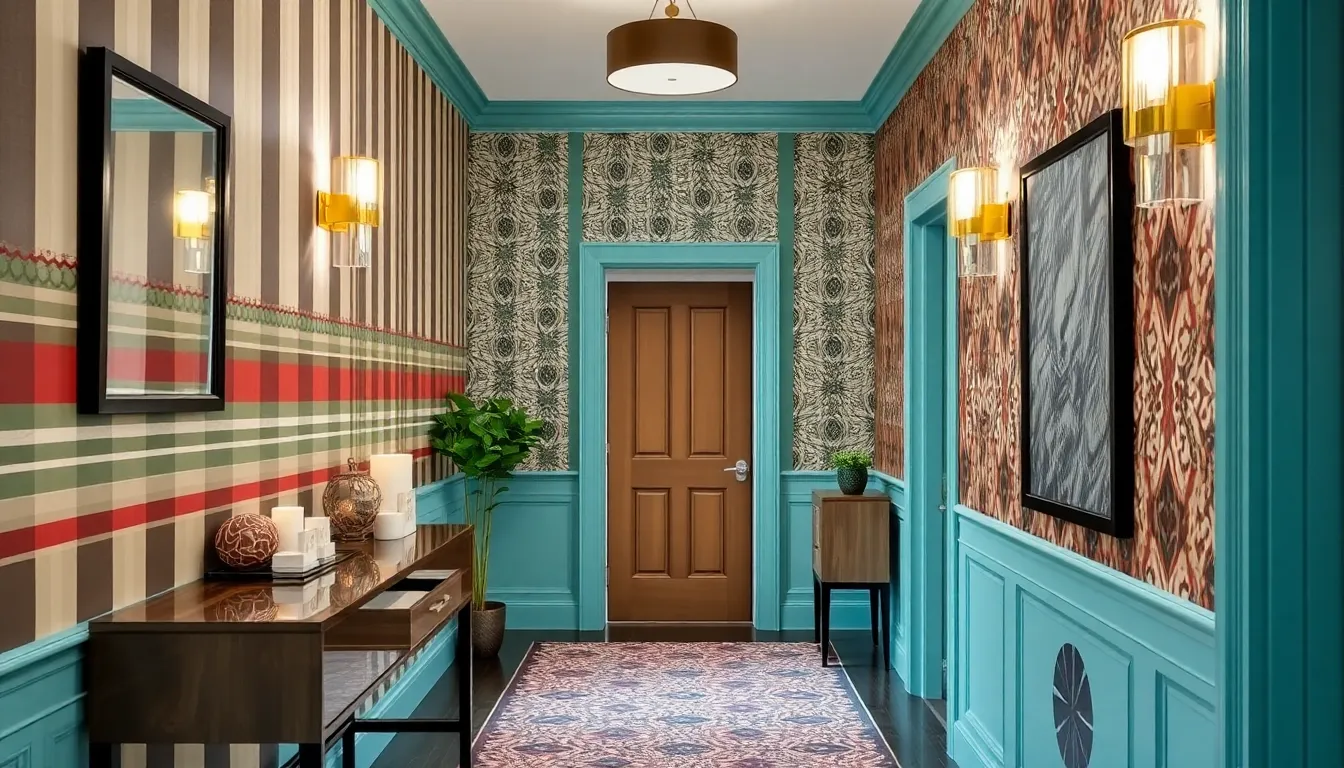
After creating beautiful gallery walls and installing statement lighting, we can amplify our hallway’s impact with vibrant wallpaper or paint colors. Bold choices transform these transitional spaces into memorable entryways that set the tone for our entire home.
Choose Patterns That Complement Your Home’s Style
Traditional homes benefit from timeless stripes and subtle geometric designs that create sophisticated backdrops without overwhelming classic architectural features. We recommend selecting patterns with muted tones that enhance crown molding and traditional trim work.
Modern interiors thrive with abstract prints and large-scale patterns that make bold statements in contemporary settings. Clean lines and geometric shapes work particularly well in homes with minimalist furniture and sleek fixtures.
Patterned tiles offer durability alongside style for high-traffic hallway areas where wallpaper might show wear. We suggest using these on accent walls or flooring to introduce pattern while maintaining practicality in busy corridors.
Create an Accent Wall for Visual Interest
Long corridors benefit from strategic accent walls that break up monotonous stretches and guide the eye along the pathway. We position these focal points at natural stopping points like doorway entrances or stairway landings.
Paint creates cost-effective accent walls using deeper shades or contrasting colors from our main palette. Dark navy or forest green works especially well behind artwork or mirrors to make these features pop.
Wallpaper accent walls introduce texture and pattern without overwhelming narrow hallway spaces. We apply bold designs to single walls while keeping adjacent surfaces neutral to maintain visual balance.
Consider Textured Wallpaper for Added Dimension
Grasscloth wallpaper brings natural texture that adds warmth and organic appeal to sterile hallway environments. This material works particularly well in homes with natural wood elements or earth-tone color schemes.
Embossed designs create subtle dimensional interest through raised patterns that catch light differently throughout the day. We choose these options when we want texture without busy visual patterns that might clash with existing decor.
Three-dimensional wall coverings offer dramatic impact for homeowners seeking maximum visual interest in their hallway spaces. These materials work best on single accent walls paired with simple lighting to highlight their sculptural qualities.
Place a Runner Rug to Define the Space and Add Comfort
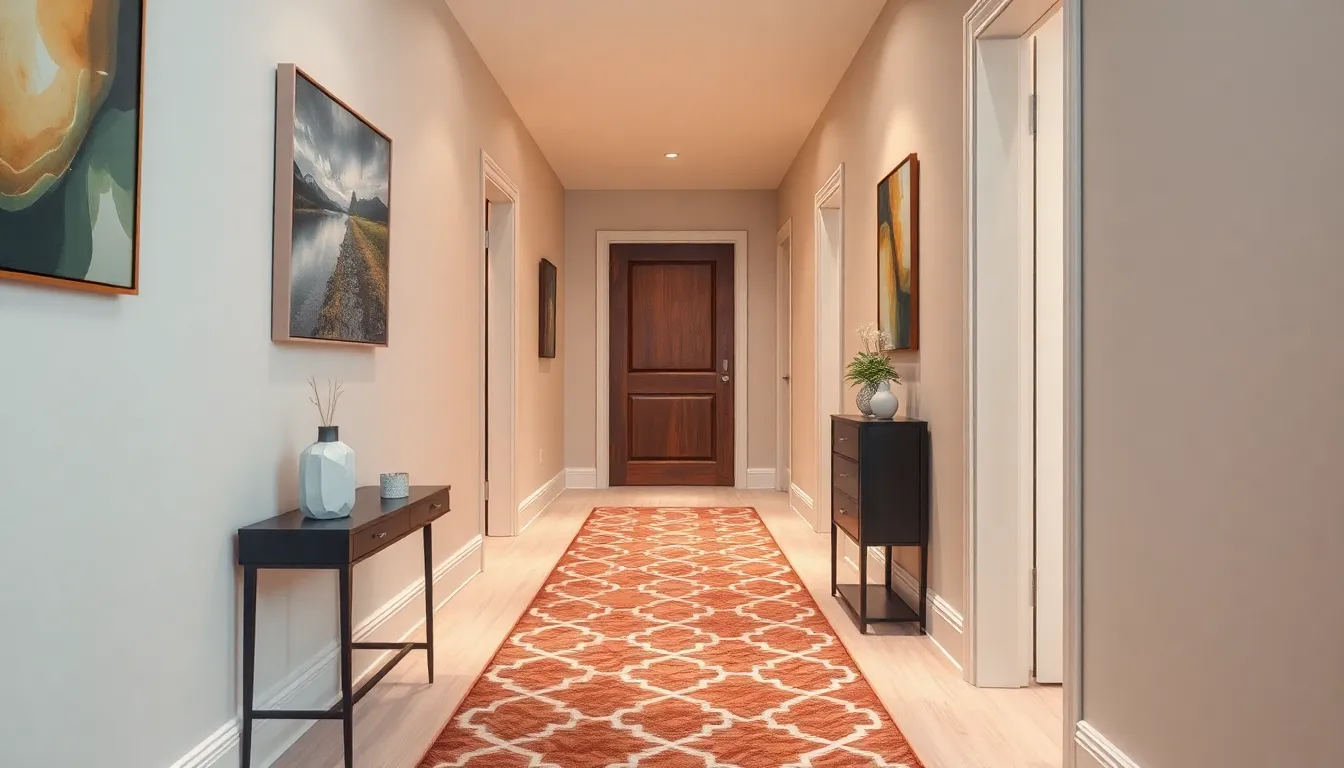
Runner rugs transform hallways from transitional pathways into defined, welcoming spaces that offer both style and comfort underfoot. We recommend incorporating these functional design elements to create visual boundaries while reducing noise from foot traffic and connecting different areas of your home seamlessly.
Select Patterns That Enhance Your Hallway’s Width
Vertical stripes work exceptionally well in narrow hallways, creating the optical illusion of expanded width and drawing the eye along the length of the space. Light-colored geometric patterns with medium-sized motifs add visual interest without overwhelming compact areas, while subtle designs like small diamonds or hexagons can make tight corridors feel more spacious.
Bold, oversized patterns should be avoided in narrow hallways as they tend to make the space feel cramped and visually cluttered. Instead, we suggest choosing designs with repeating elements that create rhythm and movement, such as traditional Persian motifs or contemporary abstract prints that guide visitors naturally through the corridor.
Horizontal elements like wide bands or chevron patterns can make long, narrow hallways appear shorter and more proportioned. Monochromatic patterns in varying tones of the same color family provide subtle texture without competing with wall art or architectural features you’ve already established in your gallery displays.
Choose Durable Materials for High-Traffic Areas
Wool runners offer exceptional durability and natural stain resistance, making them ideal for busy household corridors that experience constant foot traffic from family members and guests. Polypropylene materials provide excellent value with superior wear resistance and easy maintenance, particularly beneficial for families with children or pets who frequently use hallway spaces.
Synthetic blends combining nylon and polyester deliver impressive longevity while maintaining vibrant colors that won’t fade under regular use and cleaning. Natural fiber options like jute or sisal add organic texture but require careful consideration of their maintenance needs in high-traffic applications.
Loop pile constructions withstand heavy use better than cut pile options, distributing weight evenly across the rug surface and preventing premature wear patterns. We recommend selecting runners with low pile heights (under half an inch) to prevent tripping hazards while ensuring easy vacuuming and maintenance in frequently used pathways.
Coordinate Colors With Your Overall Design Scheme
Cohesive color coordination between your runner rug and adjacent room palettes creates seamless visual flow throughout your home’s interior spaces. We suggest pulling accent colors from nearby living areas or dining rooms to establish connections that make your hallway feel integrated rather than isolated.
Light, neutral tones like warm grays, soft beiges, or cream shades reflect available light and make narrow corridors appear larger while complementing the gallery walls and statement lighting you’ve already installed. Cool blues and soft greens work particularly well in homes with coastal or contemporary design themes, improving the calming atmosphere you’ve created with floating shelves and plant displays.
Darker colors like deep navy, charcoal, or rich burgundy can add dramatic sophistication to wider hallways but should be balanced with adequate lighting to prevent the space from feeling closed in. Bold accent colors should echo hues found in your artwork, decorative objects, or seasonal plant selections to maintain the personalized character you’ve established throughout your hallway transformation.
Add a Console Table or Bench for Practical Storage Solutions
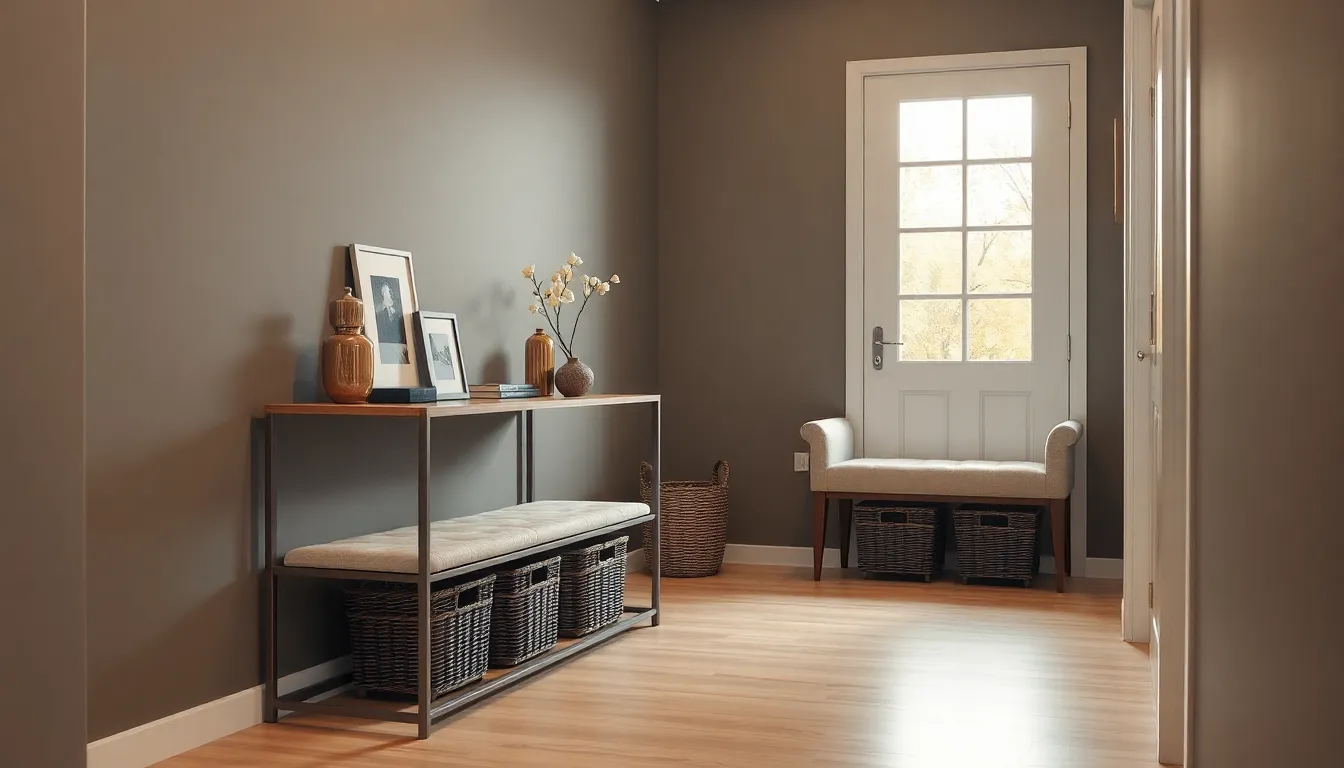
Console tables and benches transform our hallways into functional hubs that combine style with essential storage capabilities. These versatile pieces create dedicated spaces for everyday items while improving the visual appeal we’ve established through our gallery walls and lighting choices.
Style the Surface With Decorative Accessories
Decorating the top surface of our console table creates an organized display that complements our existing hallway aesthetic. We can arrange framed photos alongside small vases or decorative bowls to establish visual interest while maintaining functionality. Small trays serve dual purposes by corralling keys and loose change while adding texture to our display composition.
Coordinating these accessories with our gallery wall colors ensures seamless visual flow throughout the space. Metallic accents like brass or chrome picture frames echo the finishes in our lighting fixtures and create cohesive design connections. We should limit accessories to three to five carefully chosen pieces to avoid overwhelming the surface while keeping daily essentials easily accessible.
Provide Seating for Putting on Shoes
Benches offer essential seating that makes putting on and removing shoes comfortable and convenient for our family members. Sturdy construction supports daily use while the horizontal surface provides additional display opportunities that complement our decorative styling approach. We can position the bench at an appropriate height that accommodates both adults and children in our household.
Upholstered bench tops add comfort and visual softness that balances harder surfaces like our floating shelves and picture frames. Cushions in coordinating fabrics tie into our overall color scheme while providing practical comfort during shoe changes. Storage compartments beneath the seating surface maximize functionality without compromising the clean lines we’ve established in our hallway design.
Include Baskets or Drawers for Hidden Storage
Baskets and drawers conceal everyday items like gloves, scarves, and seasonal accessories that would otherwise create visual clutter. We can select woven baskets that complement our runner rug textures while providing easy access to frequently used items. Slimline units work particularly well in narrow hallways where we need to maximize storage without overwhelming our carefully curated displays.
Wall mounted options preserve our floor space while creating vertical storage answers that align with our floating shelf installations. Drawers offer more structured organization for smaller items and maintain the streamlined appearance we’ve achieved through our other design choices. Custom sizing ensures these storage answers fit perfectly within our available space while supporting our family’s exact organizational needs.
Incorporate Mirrors to Create the Illusion of Space and Light
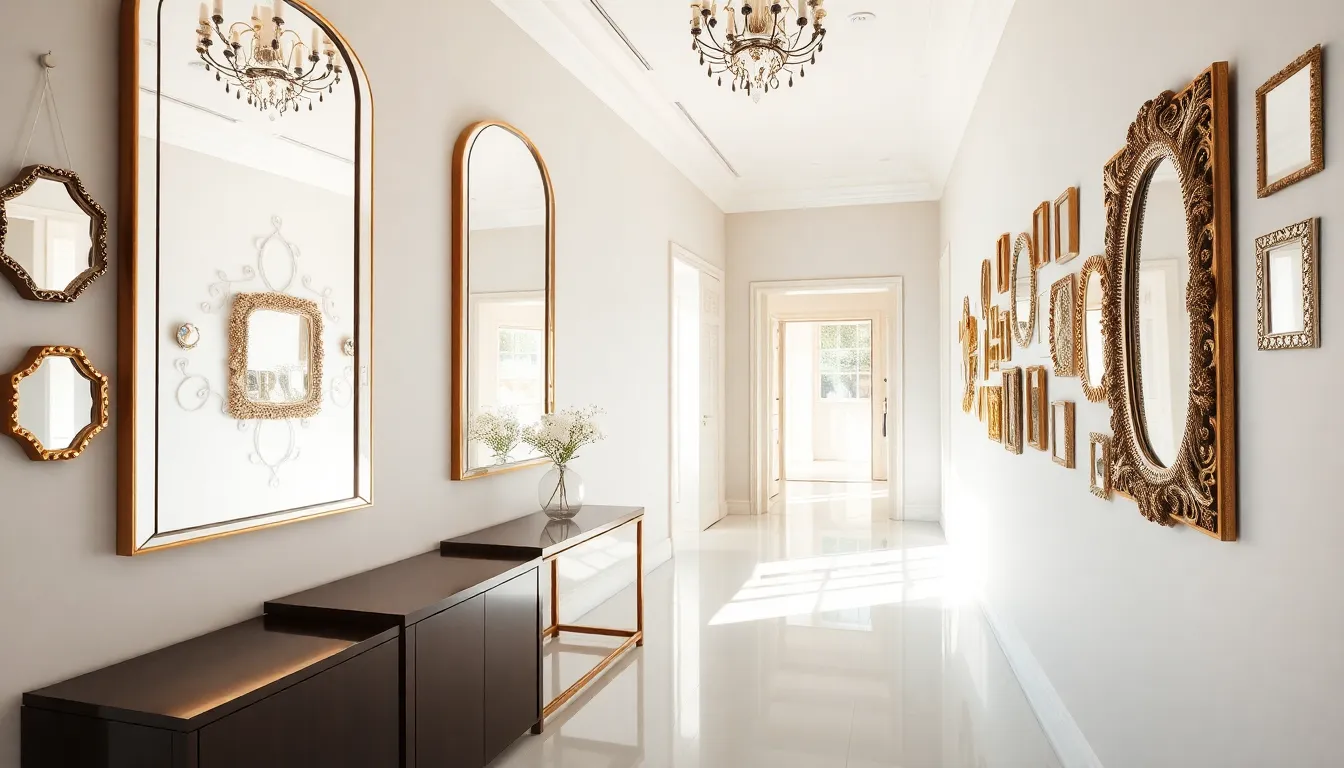
Mirrors transform narrow or dim hallways into bright, spacious passages that feel twice their actual size. Strategic mirror placement reflects both natural and artificial light throughout your hallway, creating an open atmosphere that welcomes guests.
Position Large Mirrors to Reflect Natural Light
Large mirrors positioned opposite windows or light sources maximize natural light reflection and dramatically expand your hallway’s perceived dimensions. Full-length mirrors work exceptionally well in hallways with high ceilings, adding elegance while creating the impression of increased volume and depth. Horizontal mirrors covering most of a wall invite the eye to perceive expanded space, making even the narrowest corridors feel more generous.
We recommend placing grand vertical mirrors at the end of narrow hallways to create impressive depth and eliminate that cramped corridor feeling. Floor-to-ceiling mirrors amplify natural light throughout the day, transforming dark transitional spaces into bright, welcoming pathways that enhance your home’s overall flow.
Use Multiple Small Mirrors for Artistic Effect
Multiple mirrors arranged in gallery wall formations create stunning artistic displays while brightening your hallway from various angles. Grouping mirrors of different shapes and sizes generates ever-changing reflections that serve as captivating focal points throughout your space. Arranging these mirrors on the floor first helps you visualize balanced compositions before committing to wall placement.
Gallery walls featuring mixed mirror collections add sophisticated visual interest while amplifying light distribution across your hallway’s entire length. Various mirror shapes create artistic movement that draws the eye along your corridor, making longer hallways feel more captivating and shorter ones appear extended.
Choose Decorative Frames That Match Your Style
Decorative frames that complement your existing hallway décor enhance both style and functionality while maintaining cohesive design flow. Windowpane-style frames create the illusion of additional windows, adding architectural interest and visual depth to your space. Double mirrors arranged symmetrically generate dramatic balance that elevates your hallway’s overall aesthetic appeal.
Mirrored wall panels offer sophisticated space amplification while reflecting your carefully curated décor elements throughout the corridor. Pairing framed mirrors with wall lights or lamps creates synergistic effects that expand visual space while boosting atmospheric dimension, transforming ordinary hallways into impressive design statements.
Bring in Plants and Greenery to Add Life and Color
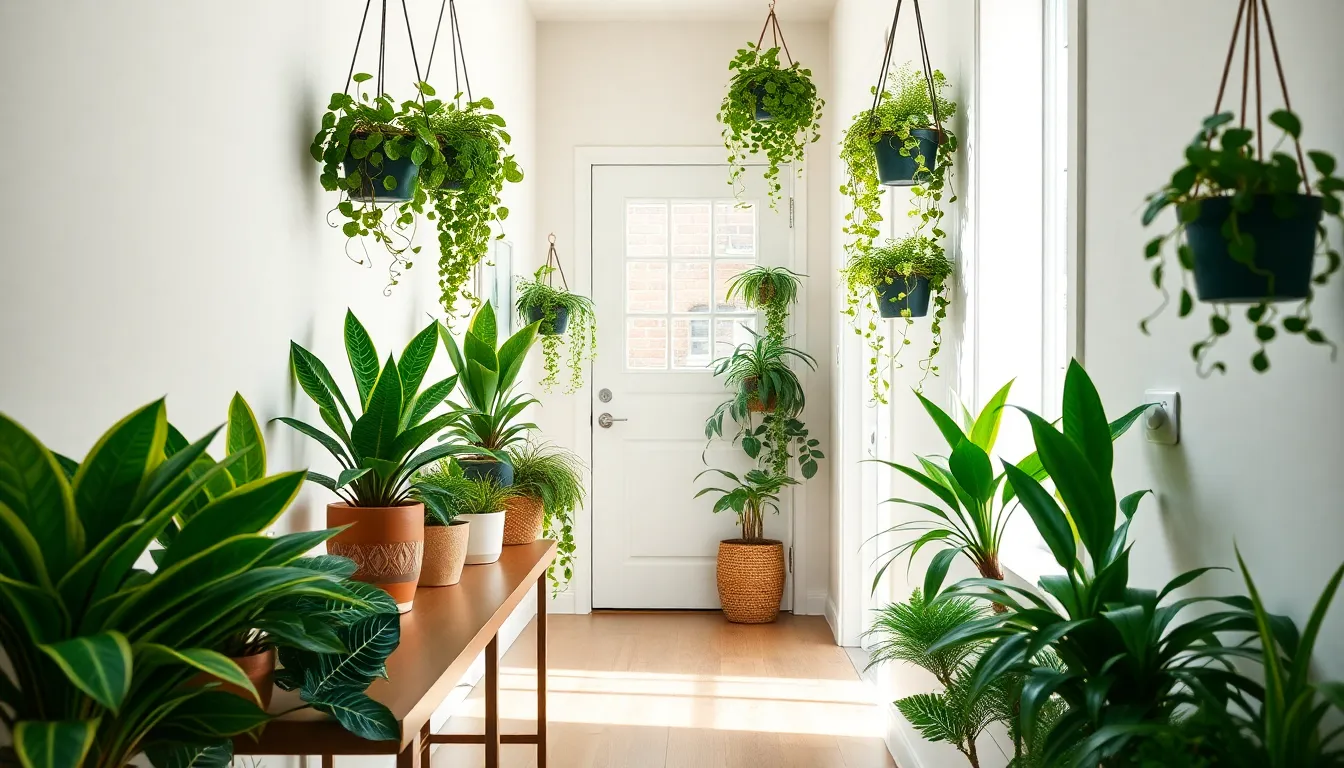
Plants bring natural vibrancy to hallways and create visual interest in these transitional spaces. We’ll transform your corridor into a lively passage using strategic greenery placement and smart plant selection techniques.
Select Low-Light Plants for Darker Hallways
Dark hallways don’t need to remain lifeless when you choose the right plant varieties. Snake plants (Sansevieria) thrive in minimal sunlight conditions and produce striking vertical leaves that complement narrow spaces. ZZ plants (Zamioculcas zamiifolia) tolerate low light environments while maintaining their glossy green appearance throughout the year.
Certain ferns adapt beautifully to dimmer hallway conditions and add soft texture to your decor. We recommend selecting these resilient species because they ensure successful growth even in challenging lighting situations. These low-light tolerant plants maintain vibrant leaves without requiring frequent repositioning or specialized care routines.
Use Hanging Planters to Save Floor Space
Hanging planters maximize your decorating potential without consuming precious floor area in narrow hallways. Trailing plants like pothos create stunning vertical displays that draw the eye upward and add movement to static spaces. Ivy produces cascading effects that soften harsh corridor lines while requiring minimal maintenance.
String of pearls offers unique texture and visual appeal when displayed in elevated planters. We suggest installing these hanging answers at varying heights to create ever-changing layering effects. This approach allows you to incorporate multiple plants without crowding walkways or creating obstacles for daily foot traffic.
Create a Small Indoor Garden Display
Small indoor garden displays transform ordinary hallway sections into captivating focal points. Arranging various plants in decorative pots on console tables introduces different textures and heights that enhance visual appeal. Tall plants serve as striking focal points while smaller succulents provide layered interest at eye level.
Grouping plants together in designated areas creates unified mini oases that feel intentional and polished. We recommend combining different plant sizes and container styles to establish ever-changing arrangements. Console tables, shelves, and plant stands provide excellent platforms for these curated displays that bring nature indoors effectively.
Install Wainscoting or Board and Batten for Architectural Interest
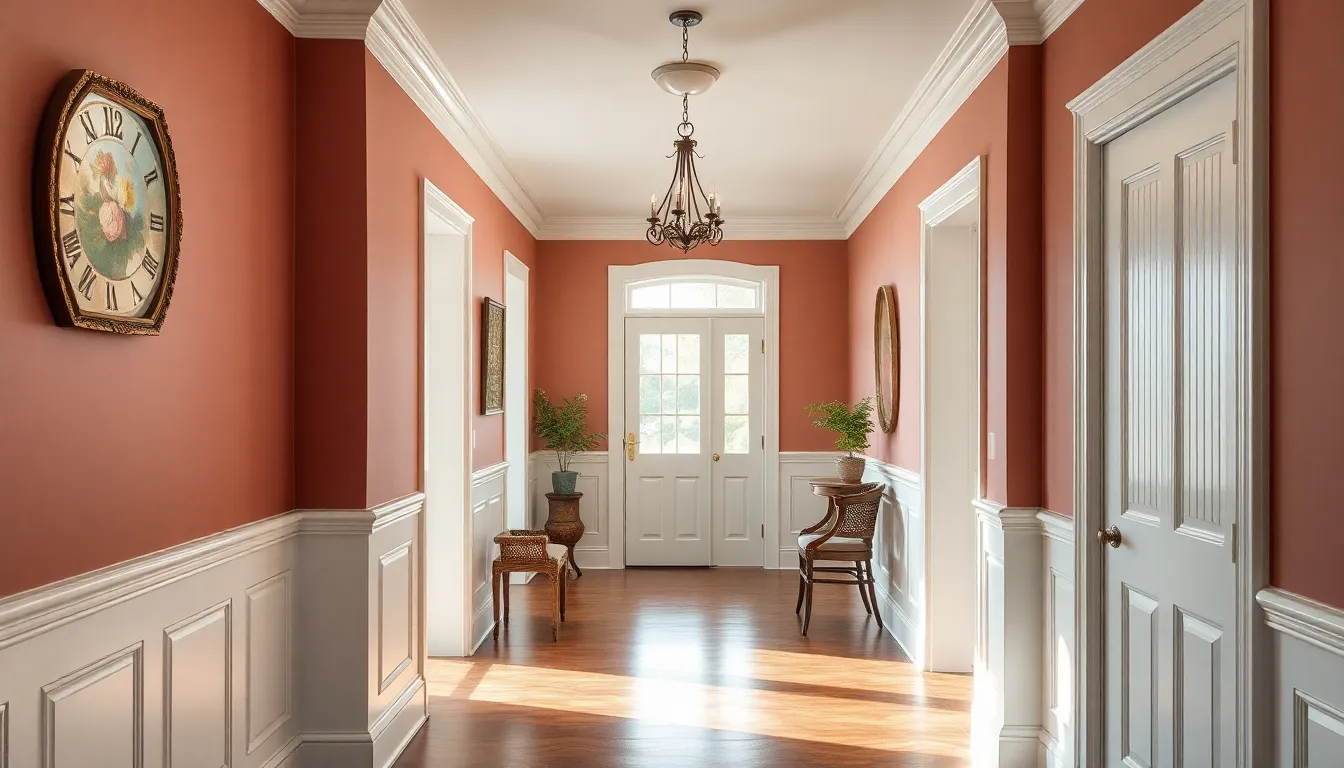
Wainscoting and board and batten installations transform plain hallway walls into stunning architectural features that add depth and sophisticated visual texture. Board and batten’s vertical paneling design creates the illusion of height in narrow hallways while introducing elegant detail without overwhelming smaller spaces.
Paint in Contrasting Colors for Visual Impact
Contrasting paint colors between walls and trim create dramatic visual separation that defines your hallway’s architectural elements. Sherwin Williams’ Accessible Beige paired with Extra White trim and board and batten delivers a modern, crisp aesthetic that visually expands the space. Paint combinations highlight architectural features like wainscoting panels and chair rail details, transforming simple corridors into striking design statements. Two tone approaches work exceptionally well when darker colors anchor the lower portion while lighter shades brighten the upper walls.
Add Chair Rails for Classic Elegance
Chair rails provide horizontal dividing lines that break up tall walls while adding timeless architectural sophistication to your hallway design. Installing chair rails allows for elegant two tone painting schemes that create visual balance and classic proportions throughout the space. Position chair rails at the traditional height of 32 to 36 inches from the floor to achieve proper scale with your hallway’s dimensions. Combine chair rails with wainscoting or beadboard below and complementary paint colors above for a polished, refined appearance that enhances your home’s overall character.
Incorporate Beadboard for Cottage-Style Charm
Beadboard paneling introduces cozy, cottage inspired texture through its distinctive narrow vertical grooves that soften harsh wall surfaces. Install beadboard as full height treatment or traditional wainscoting to add warmth and visual interest to otherwise plain hallway corridors. Light paint colors combined with beadboard’s natural texture create inviting, quaint charm that makes narrow passages feel more welcoming. Pair beadboard installations with classic molding details and soft color palettes to achieve that coveted cottage aesthetic while maintaining sophisticated appeal.
Create Built-In Storage Solutions for Maximum Organization
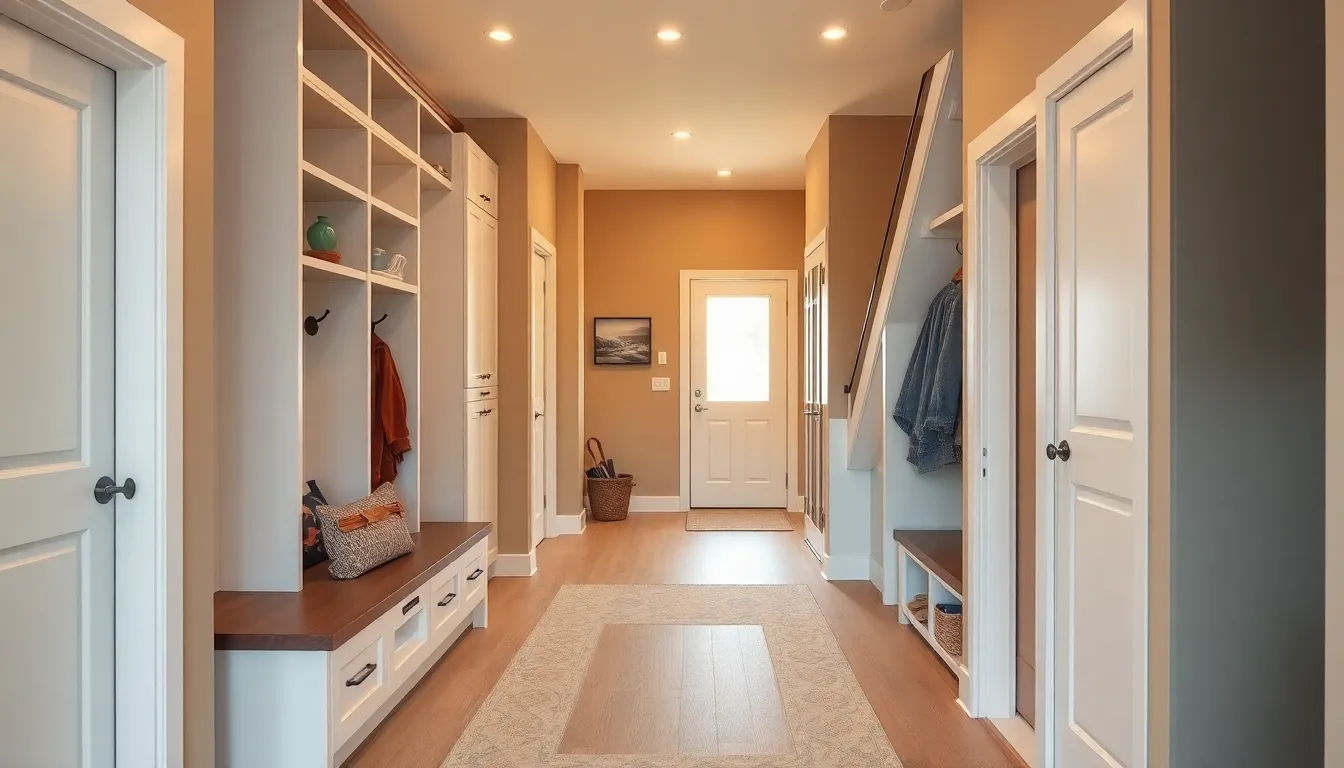
Built-in storage answers transform cluttered hallways into organized spaces that seamlessly blend function with style. Custom designed cabinetry and shelving systems maximize every square inch while creating a cohesive look throughout your hallway.
Design Custom Closets for Coats and Accessories
Custom closets optimize hallway storage by providing dedicated spaces for outerwear and accessories. Adjustable shelves accommodate items of varying heights, from tall boots to small purses, while hanging rods ensure coats remain wrinkle-free and easily accessible. Pull-out baskets create convenient storage for gloves, scarves, and seasonal accessories that might otherwise create clutter.
Integration within existing walls saves valuable floor space, making narrow hallways feel more spacious. Standalone units work perfectly in wider areas where you want to create defined storage zones. Door-mounted organizers add extra storage for small items like keys and sunglasses without taking up shelf space.
Assigning exact sections to each family member prevents the “coat pile” phenomenon that often occurs near entryways. Labels or color-coded systems help maintain organization, ensuring everyone knows exactly where their belongings belong.
Install Mudroom-Style Hooks and Cubbies
Mudroom-style features bring practical organization directly into your hallway space. Heavy-duty hooks mounted at varying heights accommodate different family members, from children’s backpacks to adult coats and bags. Cubbies beneath the hooks provide enclosed storage for shoes, sports equipment, and other daily essentials.
Benches integrated into the system create comfortable seating for putting on or removing shoes. Storage compartments within benches hide items you don’t want on display, like extra mittens or dog leashes. Open cubbies work well for frequently used items, while closed compartments keep seasonal gear out of sight.
Personalized assignments for each family member reduce confusion and streamline daily routines. Consider adding small name plates or distinctive colors to help everyone identify their designated spaces quickly.
Add Under-Stair Storage for Extra Space
Under-stair storage transforms typically wasted space into valuable organizational real estate. Custom-built shelving fits perfectly within the unique angled dimensions, creating storage that appears intentional rather than afterthought. Cabinet doors can conceal the storage area, maintaining a clean hallway appearance while hiding shoes, books, or cleaning supplies.
Pull-out drawers make accessing items in deep spaces much easier than traditional shelving. Vertical dividers keep items organized and prevent everything from sliding to the back. LED strip lighting inside cabinets ensures you can see everything clearly, even in darker under-stair areas.
Design elements that match your existing hallway decor create visual continuity throughout the space. Paint colors, hardware finishes, and door styles should complement your home’s overall aesthetic while providing the functionality you need for daily organization.
Conclusion
We’ve explored many ways to transform your hallway from a forgotten passageway into a stunning focal point of your home. From creating captivating gallery walls and incorporating statement lighting to adding functional storage answers and bringing in natural elements each approach offers unique opportunities to showcase your personal style.
The key to successful hallway decorating lies in balancing aesthetics with functionality. Whether you’re working with a narrow corridor or a spacious entryway the principles we’ve discussed can be adapted to fit your exact space and budget.
Remember that your hallway is often the first impression guests have of your home. By implementing these creative ideas you’ll create a welcoming atmosphere that seamlessly connects your living spaces while reflecting your unique personality and design preferences.
Frequently Asked Questions
What makes hallways important in home decoration?
Hallways serve as transitional spaces that connect rooms and create crucial first impressions for guests. They’re often overlooked but offer excellent opportunities to showcase personal style and enhance your home’s overall aesthetic. Well-decorated hallways can transform from mere passageways into stylish galleries that reflect your personality and add value to your living space.
How do I create an effective gallery wall in a narrow hallway?
Choose a cohesive color scheme with 3-4 complementary colors that harmonize with your existing decor. Mix different frame sizes and shapes for visual interest, and use template planning for balanced composition. Include personal photos alongside artwork to create meaningful displays. Rotate seasonal selections to keep the gallery fresh and engaging.
What lighting options work best for hallways?
Install dramatic chandeliers in wider hallways for grand impact, ensuring proper scale and design compatibility. Use wall sconces for ambient lighting in spaces with limitations, and add table lamps on console tables for both decorative appeal and practical task lighting. Proper placement enhances both aesthetics and functionality.
How can floating shelves improve hallway storage and design?
Floating shelves maximize vertical space while maintaining a clean, minimalist appearance. Display decorative objects and books in odd numbers for visual appeal, and create themed displays for cohesive looks. Mix textures and heights to add dimensional interest. Designate specific areas for different family members to maintain organization.
What plants work well in hallway spaces?
Choose low-maintenance indoor plants that thrive in typical hallway lighting conditions. Layer different plant sizes and containers to create dynamic displays. Consider air-purifying varieties to improve indoor air quality. Rotate seasonal plants to maintain year-round interest and visual appeal in your hallway space.
How do I maximize storage with built-in solutions?
Install custom cabinetry and shelving systems that blend function with style. Create custom closets with adjustable shelves and pull-out baskets for coats and accessories. Add mudroom-style hooks and cubbies for practical organization. Utilize under-stair storage for typically wasted space and assign personalized storage areas for family members.
What budget-friendly DIY options are available for hallway decoration?
Focus on simple gallery walls using personal photos and affordable frames. Add floating shelves for both storage and display. Incorporate low-cost plants and decorative objects. Use creative lighting solutions like string lights or affordable wall sconces. Paint accent walls or add removable wallpaper for dramatic visual impact.
How do I maintain visual flow throughout my hallway?
Stick to a consistent color palette throughout the space. Use similar materials and finishes for continuity. Balance decorative elements evenly along the hallway length. Ensure lighting is consistent and adequate. Create repetitive patterns or themes that guide the eye naturally through the transitional space.
